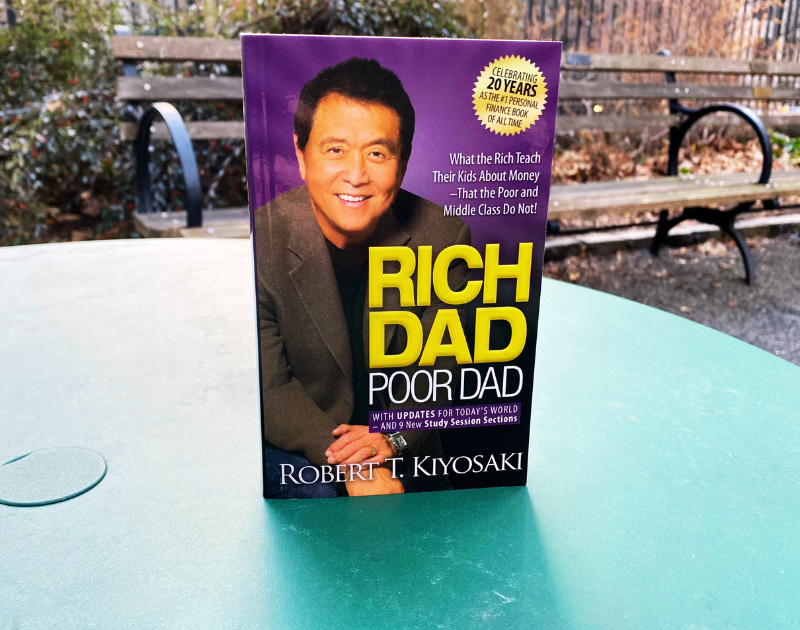Robert Kiyosaki’s Rich Dad Poor Dad is one of the most influential personal finance books of all time. It challenges traditional ideas about money, education, and wealth-building, offering a new perspective on financial freedom. In this guide, we’ll break down Rich Dad Poor Dad chapter summaries in detail, covering key lessons, real-life applications, and actionable takeaways.
Whether you’re reading for the first time or revisiting the book, this in-depth summary will help you internalize Kiyosaki’s wisdom.
Rich Dad Poor Dad Chapter Summaries #1: The Rich Don’t Work for Money
Kiyosaki introduces the contrast between his “Poor Dad” (his biological father) and his “Rich Dad” (his best friend’s father). His Poor Dad followed the conventional path: get a job, work hard, and save money. His Rich Dad, however, understood that money should work for you instead of the other way around.
Key Lessons:
- The wealthy build assets while the poor and middle class accumulate liabilities.
- Schools teach people to work for money, but they don’t teach them how to make money work for them.
- Financial education is more important than academic education when it comes to wealth-building.
Real-Life Application:
Instead of relying solely on a paycheck, start exploring passive income streams like investments, real estate, or side businesses. Understand how money flows and how to leverage it for long-term wealth.

Rich Dad Poor Dad Chapter Summaries #2: Why Teach Financial Literacy?
This chapter emphasizes financial education as the foundation for building wealth. Kiyosaki stresses that people don’t get rich because they don’t understand the difference between assets and liabilities.
Key Lessons:
- Assets put money in your pocket (stocks, businesses, rental properties), while liabilities take money out (car loans, credit card debt, mortgages).
- The rich acquire assets first, while the poor and middle class acquire liabilities they think are assets.
Real-Life Example:
A house you live in isn’t an asset—it’s a liability because it takes money out of your pocket every month (mortgage, maintenance, taxes). A rental property, however, generates income, making it a true asset.

Rich Dad Poor Dad Chapter Summaries #3: Mind Your Own Business
Most people focus on their job (working for someone else) rather than building their own business or investments.
Key Lessons:
- Don’t just work for money; build a business or invest in assets that generate income.
- Wealthy people have multiple income streams.
- Even if you have a 9-to-5 job, you should be developing a side hustle or investments.
Actionable Steps:
- Identify a side hustle: What skill or interest can you monetize?
- Start investing: Even small investments in stocks or real estate add up over time.
- Reduce dependence on a paycheck: Create a plan to build assets over time.

Rich Dad Poor Dad Chapter Summaries #4: The History of Taxes and the Power of Corporations
Kiyosaki explains how the rich legally minimize taxes through corporations and smart financial planning.
Key Lessons:
- Employees earn, get taxed, and then spend what’s left. Businesses earn, spend, and then get taxed on what’s left.
- The wealthy use tax advantages like corporations, real estate deductions, and retirement accounts to minimize their tax burden.
Example:
A small business owner can write off business expenses—home office, travel, meals—reducing taxable income. Meanwhile, an employee has no such advantage.
Rich Dad Poor Dad Chapter Summaries #5: The Rich Invent Money
Opportunities are everywhere, but only those who are financially educated recognize them. Kiyosaki emphasizes that knowledge and creativity generate wealth.
Key Lessons:
- The best opportunities aren’t found—they’re created by those who understand how money works.
- People stay poor because of fear and self-doubt, not lack of opportunity.
- Investing requires knowledge and action. Most people hesitate due to fear of loss.
Actionable Step:
Instead of saying, “I can’t afford it,” start asking, “How can I afford it?” This shift in mindset leads to problem-solving and wealth-building.
Rich Dad Poor Dad Chapter Summaries #6: Work to Learn, Not to Earn
People often focus on job security over financial independence. Kiyosaki argues that the rich work to learn new skills, not just to earn a paycheck.
Key Lessons:
- The most valuable skill sets are sales, marketing, and investing.
- Working just for a paycheck makes you dependent. Developing multiple skills creates independence.
Example:
Instead of working solely for money, seek jobs that teach valuable skills. Entrepreneurs often start in sales or marketing because those skills help them succeed in business.

Chapter 7: Overcoming Obstacles
Even with financial knowledge, many people fail to act due to fear, laziness, bad habits, and arrogance.
Key Lessons:
- Fear: Most people never invest because they fear losing money. The rich take calculated risks.
- Laziness: Excuses like “I’m too busy” prevent people from taking control of their finances.
- Bad Habits: Paying yourself first (saving/investing before spending) is a key habit of the wealthy.
Chapter 8: Getting Started
Kiyosaki gives 10 action steps to kickstart your financial education and wealth-building journey:
- Set clear financial goals.
- Take control of your spending.
- Invest in financial education.
- Learn from successful people.
- Develop a side hustle or business.
- Invest in income-generating assets.
- Work to learn, not for money.
- Surround yourself with like-minded individuals.
- Take action—don’t just read about wealth.
- Keep expanding your knowledge.
Final Thoughts
Understanding these Rich Dad Poor Dad chapter summaries can shift your mindset and put you on the path to financial freedom. The key takeaways? Invest in assets, build financial literacy, and take control of your financial future.
💬 What was your biggest takeaway from the book? Drop a comment below!
🚀 If you found this guide helpful, share it with someone who needs to hear these lessons!
